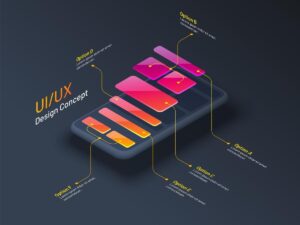Have you ever used a website or app that just felt… off? Maybe it was difficult to navigate, or you couldn’t find what you were looking for without clicking through multiple pages. Chances are, that experience left a lasting impression—just not a good one.
That’s exactly what strong UI/UX design aims to prevent.
Today, user experience is everything. People decide within seconds whether they’ll stay on your site or move on to a competitor. Great UI/UX design can be the difference between a missed opportunity and a new customer.
In this article, we’ll break down what UI and UX really mean, why they’re essential for your business, and how optimizing both can help you generate more leads and conversions.
What is UI/UX Design?
UI/UX design is the process of crafting digital experiences that are both functional and visually engaging. While the two terms often appear together, they focus on different aspects of design that work hand-in-hand.
User Experience (UX) is all about how a user feels when interacting with a website, app, or product. It involves everything from ease of use and navigation to how smoothly a user can achieve their goal—whether that’s making a purchase or finding information.
User Interface (UI), on the other hand, focuses on how that product looks and interacts visually. This includes typography, color schemes, buttons, layout, and all other elements that make the digital experience enjoyable and intuitive, according to the Interaction Design Foundation.
In simple terms, UX is how it works, and UI is how it looks. You can’t have one without the other. A website that’s stunning but hard to use loses users fast. A site that’s functional but unappealing isn’t memorable enough to convert visitors into leads.
If you want both beauty and brains in your design—something that works seamlessly and looks great while doing it—then UI/UX design is your answer.
How UI/UX Design Drives Leads
Your business might offer something amazing, but if users can’t figure out how to engage with it, they’ll never convert. The truth is, even the best offer can fall flat when paired with poor design.
Here’s how great UI/UX design encourages users to take action and drives more leads:
1. It Communicates a Clear Message
Your design should instantly tell visitors who you are, what you offer, and why they should care. When your layout, copy, and visuals work together cohesively, users connect with your brand faster—and are more likely to stick around.
A strong value proposition, presented through thoughtful design, gives users confidence that they’ve found the right solution to their problem.
2. It Guides Users With Effective Calls-to-Action (CTAs)
Your CTAs should never feel like an afterthought. Whether it’s signing up for a newsletter, booking a consultation, or starting a free trial, every CTA should be clear, visible, and inviting.
Great UI/UX ensures your CTAs stand out visually without feeling pushy. Buttons that contrast with the rest of the page, supported by persuasive copy, are key to moving users through your sales funnel.
3. It Adds Real Value for the User
Every click, scroll, and interaction should serve a purpose. If your design helps users get what they need efficiently, you’re already building trust.
A user-centered interface—simple, responsive, and purposeful—shows that your business values their time and experience. And when users feel valued, they’re far more likely to convert into paying customers.
UI vs. UX: Which Matters More?
It’s tempting to focus on looks alone, but both UI and UX are equally important. Think of it this way:
- UI without UX is like a car that looks great but doesn’t run.
- UX without UI is like a car that runs perfectly but looks dull and uninviting.
A business that wants long-term growth needs both. UX ensures your digital assets work smoothly, while UI makes users want to engage in the first place. Together, they create a cohesive experience that attracts, converts, and retains leads.
Questions to Ask When Evaluating Your UI/UX
To know if your design is truly working for you, start by asking these key questions:
- Is your contact information easy to find?
If users can’t reach you quickly, they’ll find someone else who’s easier to contact. - Is it easy to understand what your business offers?
Clear messaging and intuitive layout eliminate confusion and keep visitors focused. - Do your CTAs align with your goals?
Each button or link should guide users naturally toward the next step—without friction. - Is your homepage visually appealing and fast-loading?
Your homepage is your digital first impression. Make sure it reflects your brand’s professionalism and attention to detail. - Can users navigate your site easily?
Menus, buttons, and links should feel logical and accessible on both desktop and mobile.
If you answered “no” to any of these, it’s time to rethink your UI/UX approach.
Common UI/UX Mistakes That Kill Leads
Even small design flaws can cost conversions. Here are a few red flags to avoid:
- Overly cluttered pages
- Hard-to-read text or poor contrast
- Confusing navigation menus
- Too many pop-ups or distractions
- Slow-loading pages
- Non-responsive mobile layouts
A well-designed site eliminates barriers between your user and your offer—keeping their attention where it matters most.
Final Thoughts
The goal of strong UI/UX design is simple: make your product or website easy to use, visually appealing, and aligned with your audience’s goals. When your users enjoy interacting with your brand, you naturally create more opportunities for conversion.
If you’re ready to transform how users experience your brand online, Business Marketing Engine can help. Our certified UI/UX professionals design intuitive, high-performing digital experiences that convert visitors into leads.
Let’s build something your audience will love. Contact us today.






